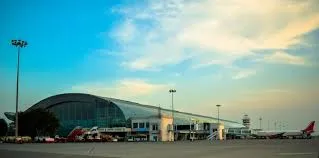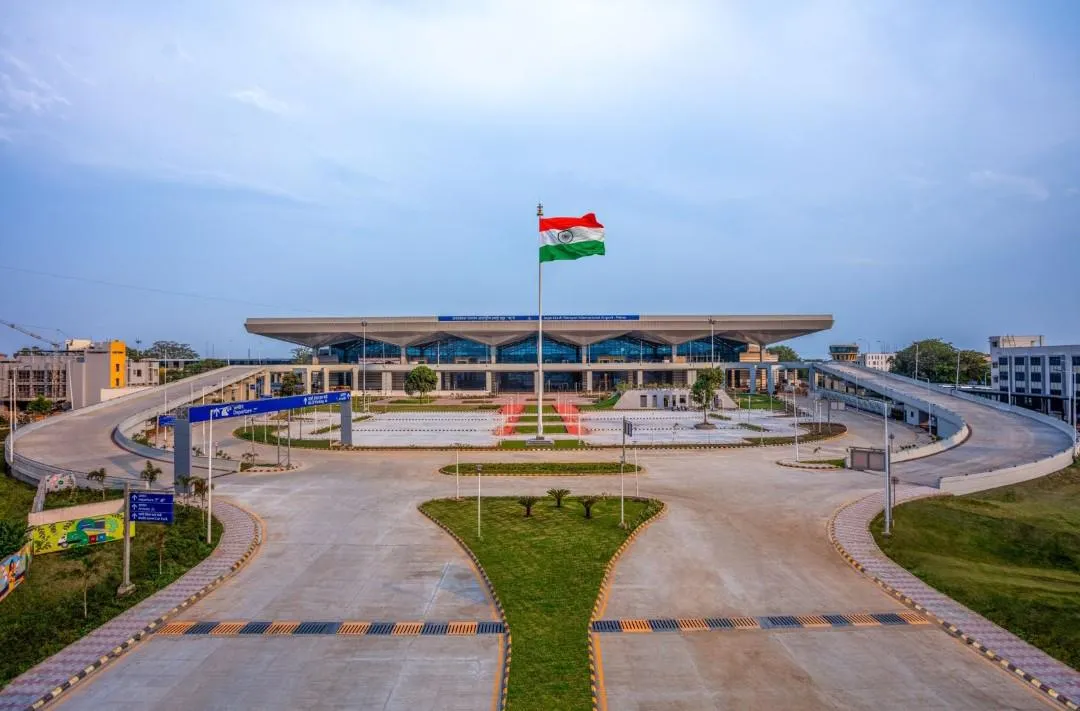Table of Contents
Netaji Subhash Chandra Bose International Airport: Gateway to Eastern India
Introduction
Netaji Subhash Chandra Bose International Airport (IATA: CCU, ICAO: VECC), commonly known as Kolkata Airport, stands as one of India's most significant aviation hubs and serves as the primary gateway to Eastern India. Named after the prominent freedom fighter Netaji Subhash Chandra Bose, this airport has evolved from a modest facility into a world-class international terminal that connects Kolkata with major cities across India and the globe.
Located approximately 17 kilometers northeast of Kolkata's city center in Dum Dum, the airport serves not only the metropolitan area of Kolkata but also acts as a crucial link for the entire Eastern and Northeastern regions of India, including states like West Bengal, Odisha, Jharkhand, Bihar, and the Seven Sister States.
Infrastructure and Capacity
Terminal Facilities
The airport underwent a major transformation with the inauguration of its new integrated Terminal 2 (T2), which represents a significant leap in capacity and passenger experience. The new integrated terminal T2 is spread over 233,000 m² (2,510,000 sq ft) and can handle 25 million passengers annually, compared to the previous terminal T1's capacity of five million. It has 112 check-in counters, 78 immigration counters, 12 customs counters, and 18 aerobridges.
The terminal is designed as an L-shaped structure containing six levels, incorporating modern amenities and cutting-edge technology. It contains 128 check-in counters that utilise CUTE (Common User Terminal Equipment) technology, ensuring efficient passenger processing and reduced waiting times.
Runway Configuration
The airport has two parallel runways: 01R/19L (11,900ft, 3,627m) and 01L/19R (9,240ft, 2,800m). As the longer one of the two, 01R/19L is now used for take-offs and landings, and 01L/19R is used primarily as a taxiway. This configuration allows for efficient aircraft movement and can accommodate various aircraft types, from regional jets to wide-body international aircraft.
Aircraft Parking and Ground Facilities
The airport's infrastructure includes comprehensive ground support facilities. The number of parking bays will be increased to 105 by 2024. The airport also features specialized facilities including Air India hangars, with Bharat Petroleum and Indian Oil serving as the primary fuel suppliers. Catering services are provided by premium operators Taj-Sats and Oberoi Flight Services, ensuring high-quality in-flight meal preparation.
Passenger Traffic and Flight Operations
Annual Passenger Volume
Kolkata Airport has shown remarkable growth in passenger traffic, recovering strongly from the pandemic-induced downturn. Kolkata's passenger count increased by 9%, reaching 21.2 million in 2024, compared to 19.4 million in 2023. This growth trajectory demonstrates the airport's importance in India's aviation sector and its resilience in the post-pandemic recovery phase.
The airport handles a substantial volume of international passengers as well. In the financial year 2024, close to 2.5 million international passengers travelled through Netaji Subhash Chandra Bose International Airport in Kolkata, India, an increase from the previous year.
Flight Operations
The airport serves as a major operational base for several airlines. IndiGo operates over 100 daily non-stop flights from Kolkata, making it one of the busiest airports in the airline's network. The airport connects to 62 destinations through direct flights, offering extensive domestic and international connectivity.
Airlines and Routes
Domestic Connectivity
Kolkata Airport serves as a crucial hub for domestic travel, connecting all major Indian cities. Major airlines operating from the airport include:
- IndiGo: The largest operator with over 100 daily flights
- Air India: National carrier with extensive domestic and international routes
- SpiceJet: Low-cost carrier serving multiple domestic destinations
- Vistara: Full-service carrier connecting major metros
- GoFirst: Budget airline serving key domestic routes
International Operations
The airport provides international connectivity to various destinations across Asia, the Middle East, and beyond. Key international routes include flights to:
- Southeast Asia: Bangkok, Singapore, Kuala Lumpur
- Middle East: Dubai, Doha, Abu Dhabi
- East Asia: Dhaka, Kathmandu
- Europe: Limited connections through Middle Eastern hubs
Cargo Operations
The airport plays a vital role in cargo transportation for Eastern India. The total covered area of air cargo terminal is 21,906 square meter and its annual holding capacity including transshipment is 120000 MT. There are four parking bays exclusively for freighter fleet, which can accommodate up to B-747 type of aircraft. This substantial cargo capacity supports the region's trade and commerce, particularly for industries like jute, textiles, tea, and information technology.
National and Regional Importance
Strategic Location
Netaji Subhash Chandra Bose International Airport holds immense strategic importance for India's eastern region. It serves as:
- Primary Gateway: The main international entry point for Eastern and Northeastern India
- Economic Hub: Facilitating trade and business connections for the region
- Tourism Portal: Key access point for tourists visiting West Bengal, Odisha, and the Northeast
- Emergency Services: Critical for disaster relief and medical emergency evacuations in the region
Regional Connectivity
The airport's significance extends beyond Kolkata, serving as a lifeline for the landlocked Northeastern states. It provides crucial connectivity for states like Assam, Meghalaya, Tripura, and others that have limited direct international flight options.
Transportation and Accessibility
Ground Transportation Options
Taxi Services
The airport offers multiple taxi service options for passenger convenience:
- Pre-paid Taxis: Pre-paid Taxis (Yellow Taxi) are available at NSCBI Airport on 24 x 7 basis and are being managed by Bidhannagar Police commisionerate. Pre-paid Taxi counters are available in Arrival Level between Gates 3 & 4.
- Radio Taxis: Mega cabs (Kolkata Call Taxi) Radio-taxi services from/to Terminal-2 of NSCBI Airport are available round the clock. Arriving passengers can avail the services at the Megacabs counters available in the Arrival Lower Level.
- App-based Services: Ola, Uber, and other ride-sharing services operate from designated pickup points
Distance and Travel Time
The distance from Kolkata Airport to the centre of Kolkata (Bara Bazar) is 14 kilometres / 8.7 miles, travel time by car is approximately 45 minutes. However, taking a Kolkata airport taxi will take around 30 minutes to complete the journey under normal traffic conditions.
Rail Connectivity
Airport Railway Station
The airport was pioneering in rail connectivity. In 2005, Kolkata Airport was the first airport in India to have a train connection. Biman Bandar railway station near Terminal 2 provided direct rail access, though this service has been temporarily suspended for infrastructure development.
Metro Connectivity
There is a metro network connecting Netaji Subhas Chandra Bose International Airport with the city center. Currently, Kolkata Metro expansion plans include two new lines, Noapara to Barasat and New Garia. For immediate metro access, a better option is a catch a taxi to Dum Dum Junction 5km from the airport. This station is a main hub for the Kolkata metro and there are many regular departures to the city centre.
Public Transportation
The public transportation in the central business and financial hub of Eastern India includes a suburban railway, metro, tram, extensive bus system and auto-rickshaws. The suburban railway network connects Kolkata suburbs with the metropolitan area.
Facilities and Passenger Amenities
Terminal Amenities
The modern Terminal 2 offers comprehensive passenger facilities including:
- Dining Options: Multiple restaurants, cafes, and food courts offering local and international cuisine
- Shopping: Duty-free shops, retail outlets, and souvenir stores
- Business Facilities: Business lounges, meeting rooms, and Wi-Fi connectivity
- Passenger Services: Information desks, medical facilities, and lost-and-found services
Lounges
The airport features several premium lounges catering to different passenger categories:
- Airline Lounges: Dedicated lounges for Air India, IndiGo, and other major carriers
- Priority Pass Lounges: Access for premium credit card holders and frequent flyers
- Business Lounges: Pay-per-use facilities for all passengers
Accessibility Features
The airport is designed with accessibility in mind, featuring:
- Wheelchair-accessible facilities throughout the terminal
- Special assistance services for passengers with reduced mobility
- Dedicated parking spaces and transportation options
- Audio-visual aids for passengers with hearing or visual impairments
Future Development and Expansion
Infrastructure Upgrades
The airport continues to evolve with ongoing development projects aimed at enhancing capacity and passenger experience. Plans include:
- Further expansion of Terminal 2 facilities
- Additional aircraft parking bays
- Enhanced cargo facilities
- Improved ground transportation links
Sustainability Initiatives
As part of India's commitment to sustainable aviation, the airport is implementing various green initiatives including:
- Solar power installations
- Waste management systems
- Water conservation measures
- Energy-efficient terminal operations
Economic Impact
Employment Generation
The airport serves as a major employer in the region, providing direct and indirect employment to thousands of people in various sectors including:
- Airport operations and management
- Airlines and ground handling services
- Retail and hospitality
- Transportation and logistics
Regional Development
The airport's presence has spurred significant development in the surrounding areas, contributing to:
- Real estate growth in nearby localities
- Development of hospitality and service industries
- Enhanced connectivity for businesses
- Attraction of foreign investment to the region
Conclusion
Netaji Subhash Chandra Bose International Airport stands as a testament to Kolkata's growing importance in India's aviation landscape. With its modern infrastructure, expanding capacity, and strategic location, the airport continues to serve as a vital gateway for Eastern India. The facility's commitment to passenger service, operational efficiency, and regional connectivity positions it as one of India's premier airports.
As the airport continues to grow and modernize, it plays an increasingly crucial role in supporting the economic development of Eastern India while maintaining its position as a key hub for both domestic and international travel. The ongoing improvements in ground transportation, including metro connectivity and enhanced taxi services, ensure that passengers can easily access this world-class facility.
The airport's significance extends far beyond its role as a transportation hub – it serves as a symbol of progress and connectivity for the entire Eastern region of India, facilitating business, tourism, and cultural exchange while contributing substantially to the region's economic growth and development.








